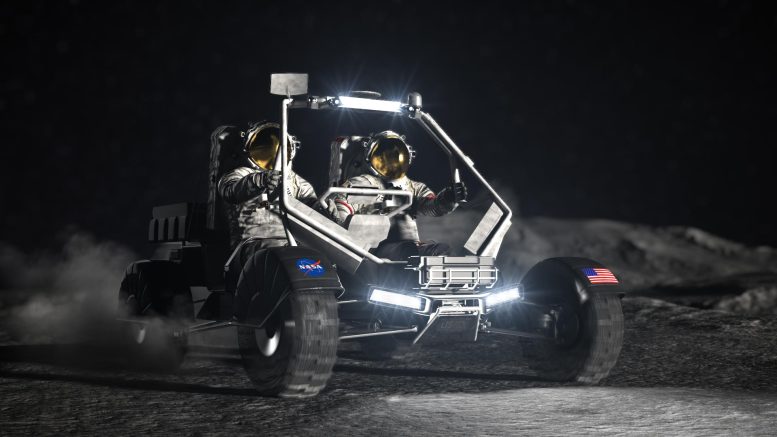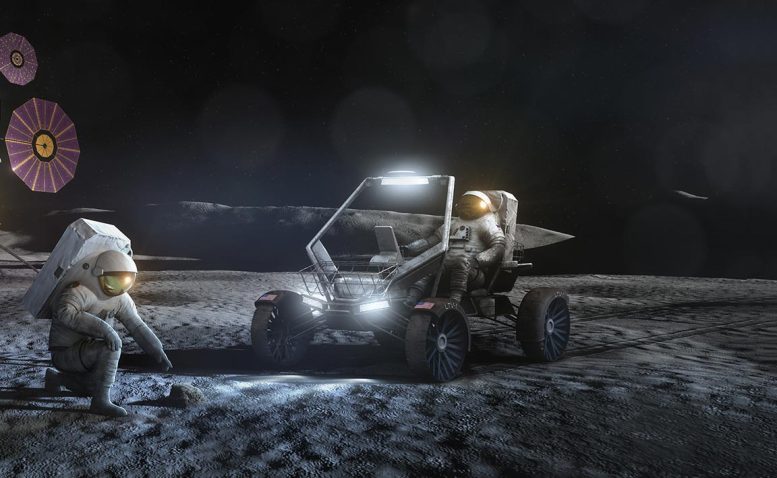
NASA is gearing up for a bold new era of lunar exploration with three advanced instruments set to investigate the Moon’s surface and subsurface.
Two will ride aboard the upcoming Lunar Terrain Vehicle—an agile, crew-capable rover—and one will orbit from above. These devices will help uncover hidden water, map minerals, and track changes caused by human activity.
Artemis LTV: A Game-Changer in Lunar Mobility
NASA has chosen three scientific instruments for upcoming missions to the Moon. Two of these will be mounted on a Lunar Terrain Vehicle (LTV), while the third is planned for use in a future lunar orbiting mission.
The LTV is a key component of NASA’s Artemis campaign, marking the return of a crew-operated vehicle to the Moon for the first time in over five decades. This versatile rover is built to carry up to two astronauts but can also function autonomously without a crew. Its design allows it to traverse a wide range of lunar landscapes, helping advance both scientific research and exploration efforts.
“The Artemis Lunar Terrain Vehicle will transport humanity farther than ever before across the lunar frontier on an epic journey of scientific exploration and discovery,” said Nicky Fox, associate administrator, Science Mission Directorate at NASA Headquarters in Washington. “By combining the best of human and robotic exploration, the science instruments selected for the LTV will make discoveries that inform us about Earth’s nearest neighbor as well as benefit the health and safety of our astronauts and spacecraft on the Moon.”

AIRES: Mapping Moon Minerals and Volatiles
One of the selected tools is the Artemis Infrared Reflectance and Emission Spectrometer (AIRES), which will detect, measure, and map various minerals and volatile compounds on the Moon. Volatiles are substances that easily transition to gas, such as water, ammonia, and carbon dioxide.
AIRES will gather spectral data layered on top of visible-light images, helping scientists understand both specific points of interest and larger regions, particularly in the Moon’s south polar area. The AIRES project is led by Phil Christensen at Arizona State University in Tempe.
L-MAPS: Uncovering Hidden Lunar Layers
The Lunar Microwave Active-Passive Spectrometer (L-MAPS) will help define what is below the Moon’s surface and search for possible locations of ice. Containing both a spectrometer and a ground-penetrating radar, the instrument suite will measure temperature, density, and subsurface structures to more than 131 feet (40 meters) below the surface. The L-MAPS instrument team is led by Matthew Siegler from the University of Hawaii at Manoa.
When combined, the data from the two instruments will paint a picture of the components of the lunar surface and subsurface to support human exploration and will uncover clues to the history of rocky worlds in our solar system. The instruments also will help scientists characterize the Moon’s resources, including what the Moon is made of, potential locations of ice, and how the Moon changes over time.
UCIS-Moon: The Moon from Orbit
In addition to the instruments selected for integration onto the LTV, NASA also selected the Ultra-Compact Imaging Spectrometer for the Moon (UCIS-Moon) for a future orbital flight opportunity. The instrument will provide regional context to the discoveries made from the LTV. From above, UCIS-Moon will map the Moon’s geology and volatiles and measure how human activity affects those volatiles. The spectrometer also will help identify scientifically valuable areas for astronauts to collect lunar samples, while its wide-view images provide the overall context for where these samples will be collected. The UCIS-Moon instrument will provide the Moon’s highest spatial resolution data of surface lunar water, mineral makeup, and thermophysical properties. The UCIS-Moon instrument team is led by Abigail Fraeman from NASA’s Jet Propulsion Laboratory in Southern California.
Powerful Trio for Deep Moon Science
“Together, these three scientific instruments will make significant progress in answering key questions about what minerals and volatiles are present on and under the surface of the Moon,” said Joel Kearns, deputy associate administrator for Exploration, Science Mission Directorate at NASA Headquarters. “With these instruments riding on the LTV and in orbit, we will be able to characterize the surface not only where astronauts explore, but also across the south polar region of the Moon, offering exciting opportunities for scientific discovery and exploration for years to come.”
Leading up to these instrument selections, NASA has worked with all three lunar terrain vehicle vendors – Intuitive Machines, Lunar Outpost, and Venturi Astrolab – to complete their preliminary design reviews. This review demonstrates that the initial design of each commercial lunar rover meets all of NASA’s system requirements and shows that the correct design options have been selected, interfaces have been identified, and verification methods have been described. NASA will evaluate the task order proposals received from each LTV vendor and make a selection decision on the demonstration mission by the end of 2025.
Artemis: Paving the Way to Mars
Through Artemis, NASA will address high priority science questions, focusing on those that are best accomplished by on-site human explorers on and around the Moon by using robotic surface and orbiting systems. The Artemis missions will send astronauts to explore the Moon for scientific discovery, economic benefits, and build the foundation for the first crewed missions to Mars.
Never miss a breakthrough: Join the SciTechDaily newsletter.
3 Comments
It may hunt for ice, but the only thing it will catch is Moon dust between its gears and break down.
Where would water have come from in the first place…and what buried it?
Some comets are mostly ice. Slamming into the moon they would have enough impetus to bury themselves. To the extent that they fractured the surface, the ice may be heated by the impact, and seep more deeply. It would have to be buried deep enough that lunar day and lunar vacuum didn’t boil it off.